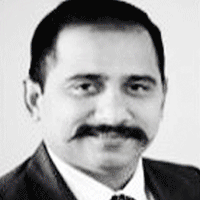


Pranesh Sridharan & Berndt Koll
Head of Business Innovation AMEA & Business Manager, New Business Areas

Lenzing
TT: Where do you see the applications of Lenzing fibres growing?
Berndt Koell: The applications will grow in the segments where performance and sustainability meet. Cellulose fibres are not the strongest fibres. But cellulose fibres can pass parameters like sustainability that are getting more important with time. Packaging technology (Packtech), especially in the food industry is one area that is extremely significant. The biggest buzzword today is 'plastic-free'. We are fighting to remove 700 billion tonnes of plastic. India has to fight 12 billion tonnes of plastic consumption every year. Hence having a biodegradable packaging is the need of the hour.
TT: Where is the application of cellulose fibres growing in technical textiles in India?
Pranesh Sridharan: We are receiving large inquiries from the footwear segment too. There is an increasing awareness about sustainability in footwear. Also, India being a hot and humid country, footwear made from Tencel provides better moisture management, which in turn provides the wearer comfort. Tencel naturally has anti-bacterial qualities and hence, there is no need for a special chemical treatment. It is safe and soft on the skin and provides odour control. A lot of leading brands have started working on this. We are also seeing a large interest from leading bag brands to make sustainable trolley bags, office bags, laptop sleeves, etc. Most brands use synthetic fibres but now are choosing to develop a sustainable range and have shown significant interest is using Tencel for such requirements. People are working with 100 per cent Tencel bags. The prototypes are ready, and we will see them in the market next year.
In the autotech sector too, we have received interest from leading manufacturers as Tencel has better thermoregulation properties than synthetic fibres. Tencel also meets technical specifications of the automobile industry in terms of the rub fastness and the wear and tear. This will really benefit consumers, especially those using cars in hot and humid climatic conditions in Asia. Footwear, packaging and autotech are where we see applications growing.
We are also working on agritech with a few customers to develop mulches and ropes as there is an increasing interest in this segment as well. But this is at a very nascent stage.
TT: What is Lenzing Lyocell India's contribution from technical textile application?
PS: Lenzing Lyocell's contribution will be close to 10 per cent with significant contribution from footwear.
TT: What challenges does the Indian technical textile industry encounter?
PS: There is an overall government support for the textile industry that is very positive now. The government is also focusing strongly on sustainability. A lot of initiatives are being taken. The kind of awareness and enforcement we see in packtech, such as avoiding single-use plastic, is not there in other segments of technical textiles. Once that falls into place, more people will start considering sustainable alternatives in other segment of this niche.
TT: Do you plan to launch any new fibres for technical textiles?
PS: We have Lenzing Modal Anthracite, which is particularly for the autotech segment. We have been successful in our initial trials and we fulfil the technical requirements of the automobile industry.
BK: Lenzing Lyocell fibres tend to fibrillate. They spin off very fine fibres from the main fibre stem. This is a very useful attribute when it comes to filtration in technical textiles. Traces are a big part of textiles. Lyocell fibres have a strong business in oil filtration in automotive sector. We have recently launched a fibre with faster fibrillation. We launched this recently in Filtech in Cologne, Germany. We plan to introduce this wet-laid technology in Asia soon.
TT: Do you see investments pouring in India in the technical textiles' realm?
BK: India has a vast scope for technical textiles, but the market now is small. If we consider the global split of technical textiles industry, roughly one-third is Americas, one-third is Europe, and only one-third is the rest of the Asian countries unlike the apparel industry. Hence there is so much to gain. With all the expertise, knowledge and talent in India, there is definitely a huge market. (HO)
Published on: 05/12/2019
DISCLAIMER: All views and opinions expressed in this column are solely of the interviewee, and they do not reflect in any way the opinion of technicaltextile.net.